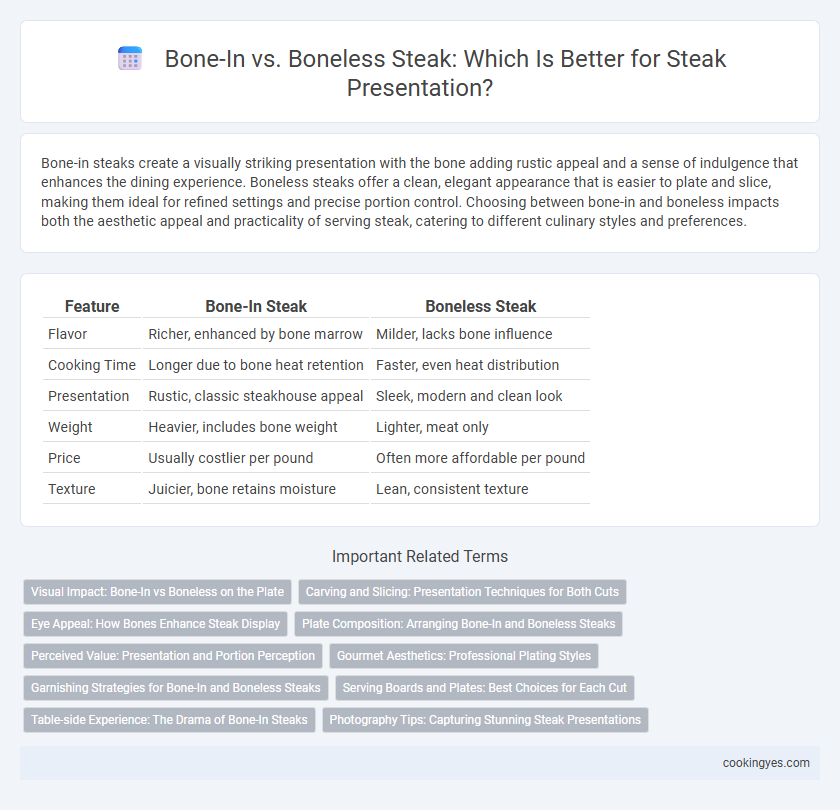Bone-in steaks create a visually striking presentation with the bone adding rustic appeal and a sense of indulgence that enhances the dining experience. Boneless steaks offer a clean, elegant appearance that is easier to plate and slice, making them ideal for refined settings and precise portion control. Choosing between bone-in and boneless impacts both the aesthetic appeal and practicality of serving steak, catering to different culinary styles and preferences.
Table of Comparison
| Feature | Bone-In Steak | Boneless Steak |
|---|---|---|
| Flavor | Richer, enhanced by bone marrow | Milder, lacks bone influence |
| Cooking Time | Longer due to bone heat retention | Faster, even heat distribution |
| Presentation | Rustic, classic steakhouse appeal | Sleek, modern and clean look |
| Weight | Heavier, includes bone weight | Lighter, meat only |
| Price | Usually costlier per pound | Often more affordable per pound |
| Texture | Juicier, bone retains moisture | Lean, consistent texture |
Visual Impact: Bone-In vs Boneless on the Plate
Bone-in steaks provide a robust visual appeal with the bone adding depth and a rustic, hearty aesthetic that enhances the plate's presentation. Boneless steaks offer a sleek and uniform look, allowing chefs to showcase grill marks and seasoning more prominently, making the dish look polished and refined. The choice between bone-in and boneless directly influences the steak's visual narrative, impacting perceived flavor intensity and overall dining experience.
Carving and Slicing: Presentation Techniques for Both Cuts
Bone-in steak offers a striking presentation with the bone serving as a natural handle, making carving visually appealing and easier to control. Boneless steak allows for uniform slicing and precise portioning, ideal for elegant plating and consistent serving sizes. Mastering techniques like segmenting along muscle fibers for boneless cuts and leveraging the bone as a guide on bone-in steaks elevates both presentation and dining experience.
Eye Appeal: How Bones Enhance Steak Display
Bone-in steaks elevate eye appeal by adding a natural, rustic element that enhances the overall presentation. The bones provide structure and contrast, creating a more visually striking plate that emphasizes the steak's thickness and juiciness. This distinctive look often conveys a sense of premium quality and craftsmanship, making bone-in steaks more enticing to diners.
Plate Composition: Arranging Bone-In and Boneless Steaks
Bone-in steaks enhance plate composition by adding visual height and rustic appeal, creating a focal point that draws the eye. Boneless steaks offer a sleek, uniform shape, allowing for more flexible arrangements alongside side dishes and garnishes. Combining both types on a plate balances texture contrast and visual interest for a sophisticated presentation.
Perceived Value: Presentation and Portion Perception
Bone-in steaks often enhance presentation by providing a rustic, visually appealing element that suggests a more substantial and hearty portion, increasing perceived value. The bone creates a natural frame, making the steak appear larger and more impressive on the plate compared to boneless cuts. This perception of size and authenticity can justify a higher price point and elevate the dining experience.
Gourmet Aesthetics: Professional Plating Styles
Bone-in steaks enhance gourmet aesthetics by adding a natural, rustic element that elevates professional plating styles and visual appeal. The bone serves as a striking focal point, creating a sense of depth and dimension on the plate that boneless cuts often lack. Chefs often use bone-in steaks to showcase culinary craftsmanship, pairing them with precise garnishes and sauces to amplify the overall presentation.
Garnishing Strategies for Bone-In and Boneless Steaks
Bone-in steaks offer a natural anchor point for garnishes such as fresh herbs, compound butters, or grilled lemon wedges, enhancing visual appeal and flavor complexity. Boneless steaks present a clean canvas suitable for delicate microgreens, edible flowers, or artfully drizzled sauces that emphasize the meat's texture. Strategic placement of colorful accompaniments around bone-in or boneless cuts creates an inviting plate that elevates the dining experience.
Serving Boards and Plates: Best Choices for Each Cut
Bone-in steaks pair exceptionally well with rustic wooden serving boards, enhancing the visual appeal of the marrow-rich bone and adding a touch of traditional elegance. Boneless steaks are best showcased on sleek ceramic or porcelain plates that emphasize precision and allow for intricate plating and garnish details. Choosing the right serving surface highlights the steak's cut, texture, and cooking style, elevating the overall presentation experience.
Table-side Experience: The Drama of Bone-In Steaks
Bone-in steaks enhance the table-side experience by adding a dramatic visual and tactile element, showcasing the primal nature of the cut. The presence of the bone offers a rustic presentation that heightens anticipation and engagement for diners. This visual impact contributes to a memorable dining moment, distinguishing bone-in steaks from their boneless counterparts.
Photography Tips: Capturing Stunning Steak Presentations
Bone-in steaks offer a rustic and visually dynamic appeal, with the marrow-filled bone adding texture and depth to photographs. Boneless steaks provide a sleek, uniform surface that highlights grill marks and seasoning details, making them ideal for close-up shots emphasizing texture and color. Use natural light and a shallow depth of field to accentuate the steak's juiciness and char, enhancing the overall visual impact of the presentation.
Bone-In vs Boneless for steak presentation Infographic

 cookingyes.com
cookingyes.com